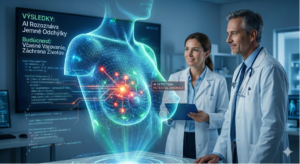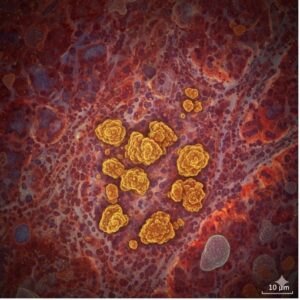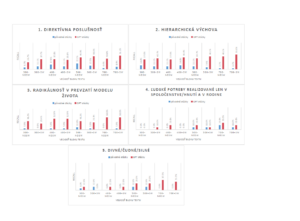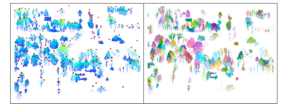Success Stories
Read about examples of good practices in the successful use of HPC in Slovakia. The utilization of supercomputers is no longer just the domain of the academic sector but is increasingly used by private companies as well – whether in manufacturing processes or in the research and development of new products.
 Success story: AI Helps Save Women’s Lives 17 Dec - Strach z rakoviny prsníka je tichým spoločníkom mnohých žien. Stačí jedno pozvanie na preventívne vyšetrenie, jeden telefonát od lekára či jedno čakanie na výsledky – a myseľ je plná otázok: „Som v poriadku?“ „Čo ak nie?“ „Môže sa niečo prehliadnuť?“
Aj keď skríning potvrdí negatívny nález, obavy často pretrvávajú.
Success story: AI Helps Save Women’s Lives 17 Dec - Strach z rakoviny prsníka je tichým spoločníkom mnohých žien. Stačí jedno pozvanie na preventívne vyšetrenie, jeden telefonát od lekára či jedno čakanie na výsledky – a myseľ je plná otázok: „Som v poriadku?“ „Čo ak nie?“ „Môže sa niečo prehliadnuť?“
Aj keď skríning potvrdí negatívny nález, obavy často pretrvávajú. Success story: The Future of Soil Hidden in Data 5 Nov - High-Performance Computing (HPC) offers researchers the ability to process enormous volumes of data and uncover connections that would otherwise remain hidden. Today, it is no longer just a tool for technical disciplines – it is increasingly valuable in social and environmental research as well. A great example is a project that harnessed the power of HPC to gain deeper insight into the relationship between humans, soil, and the landscape.
Success story: The Future of Soil Hidden in Data 5 Nov - High-Performance Computing (HPC) offers researchers the ability to process enormous volumes of data and uncover connections that would otherwise remain hidden. Today, it is no longer just a tool for technical disciplines – it is increasingly valuable in social and environmental research as well. A great example is a project that harnessed the power of HPC to gain deeper insight into the relationship between humans, soil, and the landscape. Supercomputer for Everyone: Dare to Discover the World of Modern Computing 28 Oct - Once, supercomputers were a mysterious technology accessible only to top scientists working in futuristic laboratories. Today, however, a completely new story is being written. Supercomputers are now available to ordinary users — from universities, small companies, and even public administration — anyone who needs to handle computations far beyond the capabilities of a regular computer.
Supercomputer for Everyone: Dare to Discover the World of Modern Computing 28 Oct - Once, supercomputers were a mysterious technology accessible only to top scientists working in futuristic laboratories. Today, however, a completely new story is being written. Supercomputers are now available to ordinary users — from universities, small companies, and even public administration — anyone who needs to handle computations far beyond the capabilities of a regular computer. Slovak scientists join forces in the fight against staphylococcal infection 23 Oct - Baktérie patria medzi najmenších, no zároveň najnebezpečnejších protivníkov v medicíne. Kým niektoré sú neškodné, iné dokážu spôsobiť vážne infekcie, ktorých včasná diagnostika rozhoduje o úspechu liečby. Tím slovenských vedcov preto skúma, ako odhaliť prítomnosť baktérií priamo v tkanive, rýchlo, presne a bez potreby invazívnych zásahov. Výskum spája konfokálnu Ramanovu mikroskopiu, fotodynamickú terapiu a analýzu dát na superpočítači.
Slovak scientists join forces in the fight against staphylococcal infection 23 Oct - Baktérie patria medzi najmenších, no zároveň najnebezpečnejších protivníkov v medicíne. Kým niektoré sú neškodné, iné dokážu spôsobiť vážne infekcie, ktorých včasná diagnostika rozhoduje o úspechu liečby. Tím slovenských vedcov preto skúma, ako odhaliť prítomnosť baktérií priamo v tkanive, rýchlo, presne a bez potreby invazívnych zásahov. Výskum spája konfokálnu Ramanovu mikroskopiu, fotodynamickú terapiu a analýzu dát na superpočítači.  Supercomputer Accelerated the Development of Eco-Friendly Hydrogen Production 13 Oct - Hydrogen is one of the key elements driving the transition toward sustainable energy. Its carbon-free production represents a cornerstone of the green energy future — from industry to transportation. However, finding an efficient and affordable way to produce it remains a scientific challenge that brings together chemistry, materials research, and computational modeling.
Supercomputer Accelerated the Development of Eco-Friendly Hydrogen Production 13 Oct - Hydrogen is one of the key elements driving the transition toward sustainable energy. Its carbon-free production represents a cornerstone of the green energy future — from industry to transportation. However, finding an efficient and affordable way to produce it remains a scientific challenge that brings together chemistry, materials research, and computational modeling. The computing power of HPC brings new opportunities in the protection of the brown bear 23 Sep - Vysokovýkonné počítanie (HPC) predstavuje kľúčovú technológiu modernej doby, ktorá zásadne mení spôsob, akým vedci, výskumníci aj firmy riešia zložité problémy. Superpočítače dokážu spracovať obrovské objemy dát a vykonať miliardy výpočtov za sekundu – úlohy, ktoré by na bežných počítačoch trvali mesiace či roky, zvládajú v priebehu hodín alebo dní.
The computing power of HPC brings new opportunities in the protection of the brown bear 23 Sep - Vysokovýkonné počítanie (HPC) predstavuje kľúčovú technológiu modernej doby, ktorá zásadne mení spôsob, akým vedci, výskumníci aj firmy riešia zložité problémy. Superpočítače dokážu spracovať obrovské objemy dát a vykonať miliardy výpočtov za sekundu – úlohy, ktoré by na bežných počítačoch trvali mesiace či roky, zvládajú v priebehu hodín alebo dní.  Intent Classification for Bank Chatbots through LLM Fine-Tuning 12 Sep - Tento článok hodnotí použitie veľkých jazykových modelov na klasifikáciu intentov v chatbote s preddefinovanými odpoveďami, určenom pre webové stránky bankového sektora. Zameriavame sa na efektivitu modelu SlovakBERT a porovnávame ho s použitím multilingválnych generatívnych modelov, ako sú Llama 8b instruct a Gemma 7b instruct, v ich predtrénovaných aj fine-tunovaných verziách. Výsledky naznačujú, že SlovakBERT dosahuje lepšie výsledky než ostatné modely, a to v presnosti klasifikácie ako aj v miere falošne pozitívnych predikcií.
Intent Classification for Bank Chatbots through LLM Fine-Tuning 12 Sep - Tento článok hodnotí použitie veľkých jazykových modelov na klasifikáciu intentov v chatbote s preddefinovanými odpoveďami, určenom pre webové stránky bankového sektora. Zameriavame sa na efektivitu modelu SlovakBERT a porovnávame ho s použitím multilingválnych generatívnych modelov, ako sú Llama 8b instruct a Gemma 7b instruct, v ich predtrénovaných aj fine-tunovaných verziách. Výsledky naznačujú, že SlovakBERT dosahuje lepšie výsledky než ostatné modely, a to v presnosti klasifikácie ako aj v miere falošne pozitívnych predikcií. Leveraging LLMs for Efficient Religious Text Analysis 5 Aug - The analysis and research of texts with religious themes have historically been the domain of philosophers, theologians, and other social sciences specialists. With the advent of artificial intelligence, such as the large language models (LLMs), this task takes on new dimensions. These technologies can be leveraged to reveal various insights and nuances contained in religious texts — interpreting their symbolism and uncovering their meanings. This acceleration of the analytical process allows researchers to focus on specific aspects of texts relevant to their studies.
Leveraging LLMs for Efficient Religious Text Analysis 5 Aug - The analysis and research of texts with religious themes have historically been the domain of philosophers, theologians, and other social sciences specialists. With the advent of artificial intelligence, such as the large language models (LLMs), this task takes on new dimensions. These technologies can be leveraged to reveal various insights and nuances contained in religious texts — interpreting their symbolism and uncovering their meanings. This acceleration of the analytical process allows researchers to focus on specific aspects of texts relevant to their studies. Mapping Tree Positions and Heights Using PointCloud Data Obtained Using LiDAR Technology 25 Jul - Cieľom spolupráce medzi Národným superpočítačovým centrom (NSCC) a firmou SKYMOVE, v rámci projektu Národného kompetenčného centra pre HPC, bol návrh a implementácia pilotného softvérového riešenia pre spracovanie dát získaných technológiou LiDAR (Light Detection and Ranging) umiestnených na dronoch.
Mapping Tree Positions and Heights Using PointCloud Data Obtained Using LiDAR Technology 25 Jul - Cieľom spolupráce medzi Národným superpočítačovým centrom (NSCC) a firmou SKYMOVE, v rámci projektu Národného kompetenčného centra pre HPC, bol návrh a implementácia pilotného softvérového riešenia pre spracovanie dát získaných technológiou LiDAR (Light Detection and Ranging) umiestnených na dronoch. Semi-Supervised Learning in Aerial Imagery: Implementing Uni-Match with Frame Field learning for Building Extraction 21 Jun - Extrakcia budov v Geografických informačných systémoch (GIS) je kľúčová pre urbanistické plánovanie, environmentálne štúdie a riadenie infraštruktúry, pretože umožňuje presné mapovanie stavieb, vrátane odhaľovania nelegálnych stavieb za účelom dodržiavania právnych predpisov, alebo efektívnejšieho vyberania daní. Integrácia extrahovaných údajov o budovách s inými geopriestorovými vrstvami zlepšuje pochopenie dynamiky miest a priestorových vzťahov.
Semi-Supervised Learning in Aerial Imagery: Implementing Uni-Match with Frame Field learning for Building Extraction 21 Jun - Extrakcia budov v Geografických informačných systémoch (GIS) je kľúčová pre urbanistické plánovanie, environmentálne štúdie a riadenie infraštruktúry, pretože umožňuje presné mapovanie stavieb, vrátane odhaľovania nelegálnych stavieb za účelom dodržiavania právnych predpisov, alebo efektívnejšieho vyberania daní. Integrácia extrahovaných údajov o budovách s inými geopriestorovými vrstvami zlepšuje pochopenie dynamiky miest a priestorových vzťahov. Named Entity Recognition for Address Extraction in Speech-to-Text Transcriptions Using Synthetic Data 22 Dec - Many businesses spend large amounts of resources for communicating with clients. Usually, the goal is
to provide clients with information, but sometimes there is also a need to request specific information
from them.
In addressing this need, there has been a significant effort put into the development of chatbots
and voicebots, which on one hand serve the purpose of providing information to clients, but they can
also be utilized to contact a client with a request to provide some information.
A specific real-world example is to contact a client, via text or via phone, to update their postal address. The address may have possibly changed over time, so a business needs to update this information
in its internal client database.
Named Entity Recognition for Address Extraction in Speech-to-Text Transcriptions Using Synthetic Data 22 Dec - Many businesses spend large amounts of resources for communicating with clients. Usually, the goal is
to provide clients with information, but sometimes there is also a need to request specific information
from them.
In addressing this need, there has been a significant effort put into the development of chatbots
and voicebots, which on one hand serve the purpose of providing information to clients, but they can
also be utilized to contact a client with a request to provide some information.
A specific real-world example is to contact a client, via text or via phone, to update their postal address. The address may have possibly changed over time, so a business needs to update this information
in its internal client database.  Anomaly Detection in Time Series Data:
Gambling prevention using Deep Learning 28 Jun - Gambling prevention of online casino players is a challenging ambition with positive impacts both on player’s well-being, and for casino providers aiming for responsible gambling. To facilitate this, we propose an unsupervised deep learning method with an objective to identify players showing signs of problem gambling based on available data in a form of time series. We compare the transformer-based autoencoder architecture for anomaly detection proposed by us with recurrent neural network and convolutional neural network autoencoder architectures and highlight its advantages. Due to the fact that the players’ clinical diagnosis was not part of the data at hand, we evaluated the outcome of our study by analyzing correlation of anomaly scores obtained from the autoencoder and several proxy indicators associated with the problem gambling reported in the literature.
Anomaly Detection in Time Series Data:
Gambling prevention using Deep Learning 28 Jun - Gambling prevention of online casino players is a challenging ambition with positive impacts both on player’s well-being, and for casino providers aiming for responsible gambling. To facilitate this, we propose an unsupervised deep learning method with an objective to identify players showing signs of problem gambling based on available data in a form of time series. We compare the transformer-based autoencoder architecture for anomaly detection proposed by us with recurrent neural network and convolutional neural network autoencoder architectures and highlight its advantages. Due to the fact that the players’ clinical diagnosis was not part of the data at hand, we evaluated the outcome of our study by analyzing correlation of anomaly scores obtained from the autoencoder and several proxy indicators associated with the problem gambling reported in the literature.